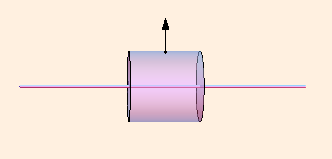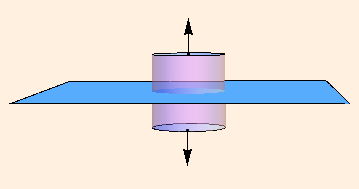
| (prev) | (top) | (next) |
E * 4 π r2 = 4/3 π a3 ρ / ε
E = a3 ρ / (3 ε r2)
E * 2 π r h + 0 * 2 * π r2 = h λ / ε
E = λ / (2 π ε r)
Plane at z = 0, field point at (0,0,z), Gaussian cylinder of radius r and height 2z:
E * π r2 + E * π r2 + 0 * 2 π r * 2 z = π r2 σ / ε
E = σ / (2 ε)
Consider again the electric field due to a linear charge density λ extending from
(-b,0) to (b,0), with the field point at (0,y). Ignoring the finite length, Gauss' law gives us
For a disc of radius b, thickness d and charge density ρ (with the field point again a distance y from the center and ignoring the finite radius
for Gauss' law),
Ez = ρ (d + √ ((y + d)2 + b2) - √ (y2 + b2)) / (2 ε)
Ez / EGauss = 1 - (b / d) (√ (1 + (y / b)2) - √ (1 + ((y + d) / b)2))
For less symmetric shapes (like rectangles), the closest edge is most important in determining the error.
Note that any finite charge distribution looks like a spherically symmetric charge distribution from sufficiently far away.
It is surrounded by
a spherically symmetric nonconducting shell, extending to a distance r2 from the center of the sphere, with uniform charge q2.
That in turn is surrounded by a neutral conducting shell which extends to a distance r3 from the center of the sphere:
In order for Gauss' law to hold, this latter shell must have
charge -(q1 + q2) on the inside surface and charge q1 + q2 on the outside surface, since E = 0 inside.
We can use Gauss' law to compute the magnitude of the electric field everywhere in space:
Gauss' Law
Φ ≡ ∫ E ⋅ dA
where the direction of dA is the outward unit normal to the surface.
Φclosed surface = qinside / ε
Gauss' law is especially useful when the electric field is constant along faces of the closed surface, and is either
perpendicular to or parallel to each of the faces. The following "Gaussian surfaces" are often useful:
Remember that the Gaussian surface must intersect the field point!
A solid charged ball of radius a, field point a distance r from the center:
 A line of charge with field point at distance r, Gaussian cylinder of height h:
A line of charge with field point at distance r, Gaussian cylinder of height h:


EGauss = λ / (2 π ε y)
Coulomb's law gives
Ey = λ b / (2 π ε y √ (y2 + b2))
The ratio of the two is
Ey / EGauss = 1 / √ (1 + (y / b)2)
So, for instance, if the ends are 10 times further away than the field point, the error is 0.5 %.
≈ 1 - 1 / (2 (b / y)2)
(using a Taylor series in x = y / b) in the limit b >> y.
EGauss = ρ d / (2 ε)
≈ 1 + 1 / (b / y) + 1 / (2 b / d)
in the limits b >> y and b >> d. So if the edge is 10 times further away than the field point, the error is now 10 % for negligible thickness,
but climbs to 15 % if the radius is only 10 times the thickness.

r ≤ r1 E = 0 r1 < r < r2 E = (1 / (4 π ε)) (q1 / r2 +
q2 ((r3 - r13) / (r23 - r13)) / r2) r2 ≤ r ≤ r3 E = 0 r > r3 E = (1 / (4 π ε0)) (q1 + q2) / r2
| (prev) | (top) | (next) |
©2011, Kenneth R. Koehler. All Rights Reserved. This document may be freely reproduced provided that this copyright notice is included.
Please send comments or suggestions to the author.